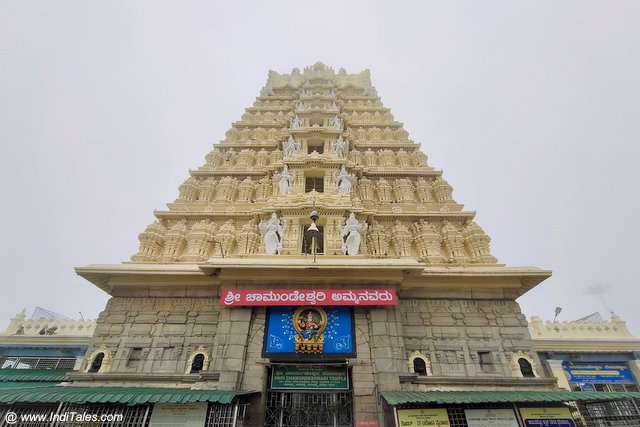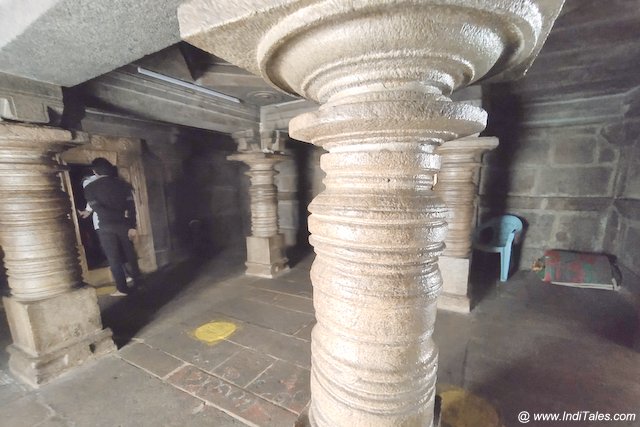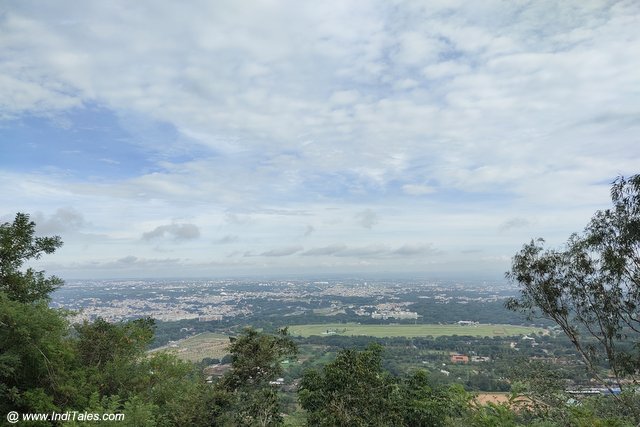SRI CHAMUNDESHWARI TEMPLE ON CHAMUNDI HILLS IN MYSURU
SRI CHAMUNDESHWARI TEMPLE ON CHAMUNDI HILLS IN MYSURU
Sri Chamundeshwari Temple is one of the 18 Shaktipeethas mentioned by Adi Shankaracharya. It is located on the Chamundi hills close to the city of Mysuru (formerly called Mysore) which is associated with the legend of Devi.
Story of Chamundeshwari Devi
Chamunda or Chamundeshwari comes in the stories of Devi as mentioned in Devi Mahatmya or Durga Saptashati as part of Markandeya Purana. In this text, Devi takes different swaroops or manifestations to kill different asuras who appear from time to time. The manifestation that killed the twin asuras of Chanda and Munda came to be known as Chamunda.

She is also the one who killed half man half buffalo asura Mahishasura and is therefore known as Mahishasura Mardini. It is believed that Mahishasur was killed here on Chamundi hills and hence the city of Mysuru derives its name from the Asura. This is not uncommon at all. Kolhapur derives its name from asura Kolasur who was killed by Mahalakshmi in Karveerpur which is now called Kolhapur after the Asura.
Residing on top of Chamundi hills, named after her, Chamundeshwari is the Kshetra Devata of the region surrounding the hills. This includes the city of Mysuru – which is the cultural capital of the state of Karnataka. Being a royal city, Chamundeshwari is also the Kuldevi of the royal family of Mysuru. She is in fact the state deity of Karnataka.
She is also known as Naada Devi. The famous Mysore Dussehra also starts from here with her permission. Dussehra is also known as Naada Habba in Mysuru.
As a Shaktipeetha, it is called Kraunchpatnam by Adi Shankaracharya and is otherwise referred to as Kraunch Peetha. It is believed that the hair of Devi Sati fell here when Shiva was roaming with her dead body and Vishnu cut it with his Chakra.
Sri Chamundeshwari Temple
The ancient temple is located on top of the hill at a mean sea level of 3400 feet. Many Devi temples are located on hilltops and in the good old days, devotees used to climb the bare hills. As the civilizations and kingdoms came up, temples became grander, and the approach to the temples became simpler.

Built-in the typical Dravidian style, with a tall gopuram in pale yellow color, the temple overlooks the city of Mysuru. The temple as it stands today dates back to the 12th CE and the Hoysala dynasty. The later additions like gopurams were probably done by the Vijayanagara kings. Notable though are the 1000-odd, stone stairway steps that lead to the temple carved sometime in mid-17th CE by Maharaja Dodda Devaraja of Mysuru. There are stories of many Mysuru Maharajas visiting the temple and receiving blessings in different forms.
The temple itself is not very big. But for the crowd, you can easily walk around the temple. You enter through the tall seven-story Gopuram that is painted in pale yellow color. You need to stretch your neck to see the golden Kalasha placed on top of the Gopuram.
As you enter there is Navaranga Mandapa and Antarala Mandapa followed by Garbhagriha. The temple is surrounded by a wall that is called Prakara.
Ganesha, Hanuman, and Bhairava
There are smaller shrines dedicated to Ganesha, Hanuman & Bhairava inside the temple. The main door is flanked by the doorkeepers or Dwarpalikas called Nandini and Kamalini. Mysuru King Krishnaraja Wodeyar III along with his wives Ramavilasa, Lakshmivilasa, and Krishnavilasa are also present in the temple as a devotee. I however missed this due to the heavy crowd.
The Main Murti of Devi is Ashtabuja or with eight hands as described in the Markandeya Purana. It is also believed that probably it was Rishi Markandeya who first consecrated the Murti here. Sri Chakra, as the geometrical representation of Devi, is also worshipped here.
Temple is surrounded by small shops selling flowers and puja items. The main prasad offered here is Laddu, something like Tirupati Laddu. Beneath the trees, I found the Naga Murtis – something that is ubiquitous in South India.

Festivals at Chamundeshwari Temple
Being a Devi temple, Fridays are important at the temple. You will see a lot more people visiting on this day.
Apart from daily Abhishek every morning and evening, Chamundeshwari Devi is also offered a gun salute or guard of honor every evening. The practice was started by the Wodeyar Maharajas of Mysuru after Tipu Sultan was killed and they regained their kingdom.
Ashadha Shukrawara
Fridays of the Ashadha Masa or the month of Ashadha that falls in July-August of the Julian calendar, special celebrations take place at the temple.
Chamundi Jayanti
Chamundi Jayanti is celebrated on the Ashadha Krishna Saptami or the 7th day of the dark fortnight of Ashadha month. On this day, Devi steps out in her golden palanquin and goes around the temple in the form of her Utsava Murti.
Mysuru royal family participates in the Puja and seeks blessings to rule the state with her guidance and without prejudice.
Navaratri & Nada Habba or Dussehra
Navaratri in Chaitra and Ashwin months are celebrated with great fervor like they are in any Devi temple across the country. At Chamundeshwari temple, for nine days, Shringar of Devi is done in nine different swaroops or manifestations of the goddess, collectively called Navadurga. On some days, her Shringar including the jewelry comes from the royal treasury of Mysuru.
Chamundi is an integral part of the famous Mysuru Dussehra. We shall talk about that some other day.
Other important days at the temple are:
- Shayanautsava on Ashwin Krishna Tritiya
- Mudi Utsava on Ashwin Krishna Panchami
- Vasantotsava on Chaitra Pratipada or first day of Chaitra Navaratri
- Kritikotsava on Kartika Poornima
- Rathotsava Asvayuja or Ashwin Poornima day in the morning
- Teppotsava Ashwin Krishna Dvitiya in the Evening
- Sri Mahabaleswara Rathotsava Phalguna Ksirhna Sashthi
- Uttanahalaii jwalamuki temple jatra on 3rd Sunday of Magha Masa
Mahabaleshwar Temple
About 100 meters away from Chamundeshwari Temple is a small Shiva temple in stone. It has the typical Hoysala pillars telling us that it was built by them. There is a stone inscription in Kannada that can be seen on the premises.

The mandapa of the temple is full of Murtis. I remember a panel of Saptamatrikas on one side of the Garbhagriha.

We visited the temple early morning, so we could attend the Arti here. It was a beautiful experience as there were a handful of people only. It is strange that the Chamundi temple is full of people and you can hardly take the darshan. But this temple is more or less empty and allows you to spend some time with the deity.
This temple may be older than the Chamundeshwari temple or its contemporary. The hill was also called Mahabaladri hill after this temple before Chamundi hills became a more popular name.
There is also a Narayanaswamy temple close by.
Nandi Murti & Shiva Temple
At the 700th step of the staircase leading up the Chamundi hills, is a giant stone carved Nandi Murti. The giant Nandi has been carved out of a single stone and is very proportionate. Nandi Murtis as we know are very popular in this region. They can be bigger than the Shivalingas at times. Most pilgrims stop to visit the Nandi, regardless of the route they are taking.

These days it has become a famous point to click and get clicked. For those climbing the stairs, it is a good resting point. There is a proper platform that allows you to take pictures without going close to the Nandi.
16 feet high and even longer (25 feet long), the Nandi reminds you of your height when compared to the divine. It wears a lot of chains and bells around its neck that go all the way around its body. They are exquisitely carved and worth the visitor’s attention. It was also built by Dodda Devaraja who built the steps to ease the journey of pilgrims.
If Nandi is around, Shiva can not be far behind. There is a small Shiva temple close to the Nandi platform.
Mahishasur Murti
A giant Mahishasur Murti stands on top of the hill holding a sword and a Naga or snake in his hands. It is a reminder of the victory of good over evil. And the fact that devatas descend on earth when the adharma increases beyond a point.
Chamundi Hills
Besides the more popular temple atop, Chamundi Hills is also popular among early morning walkers/joggers, for the sunrise and sunset viewpoints, pleasant weather, and lush green vegetation. Merely 13 km away from the city, the range of hillocks has a periphery of about 11KM. The forest on the hills are protected reserve forest and is home to a few endangered flora and wildlife. It is a tropical deciduous thorn scrub forest. There are over 440 species of flowering plants. About 190 species of birds have been spotted here out of which about 130 are residents. over 150 species of Butterflies were also found over a period of time. The hill forest is a habitat for Monkeys, Civets, Leopards, mongooses, etc. The nature trails on Chamundi Hills can be enriching, however, go with guides and in groups well prepared for the adventure and with permission from authorities.
View of Mysuru
You get a lovely bird’s eye view of Mysuru city from Chamundi hills. As I looked at the city from various vantage points, it looked to me like a white city. Many of its prominent buildings are white.

If you know the city or have a local guide, they can give you an aerial tour of the city from here. You can see as far as Krishnarajasagara dam on a clear day.
Jwalamalini and Tripursundari Temple
As you come down the Chamundi hills, you can take a detour towards Uttanahalli village. It is almost at the foothill of the main hill. Here there is a temple dedicated to twin goddesses Jwalamalini and Tripursundari. The two Devis are believed to be the sisters of Chamundi.

The two temples are located side by side. There is a lovely Shiva temple on the premises. I could also see some stone Bhairava Murtis that are always a part of Devi Kshetra. It is said that in earlier days kings used to visit these temples before going to war, seeking the blessings of the Devi.
You will always find the temples of different manifestations of Devi in close vicinity. For example, in Kolhapur, we have Mahalakshmi surrounded by Kalika Devi and Renuka Devi.
Travel Tips
- Temple is located at a height. You can either climb the hill or drive up. There are regular buses from Mysuru that take you up the hill.
- Chamundeshwari Temple visitor timings are 7:30 AM-2 PM and then 3:30-6 PM & 7:30-9:00 PM.
- There is a VIP darshan ticket that allows you to enter from the side in a smaller queue.
- Free food is served at the temple during lunchtime. Though it is advisable to donate if you can afford it.
- Be careful of monkeys if you are holding any eatables in your hands.
- No photography is allowed inside the temple, outside you can click pictures.
- Chamundi hill is still full of forest and wildlife so be careful of venturing deep into the woods.
- There is adequate parking space available atop the hill if you wish to drive.
- Refreshments and souvenir shops are there for the interested.

Comments
Post a Comment